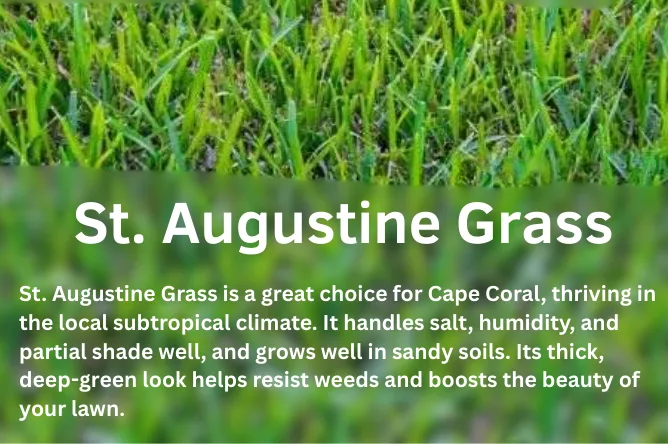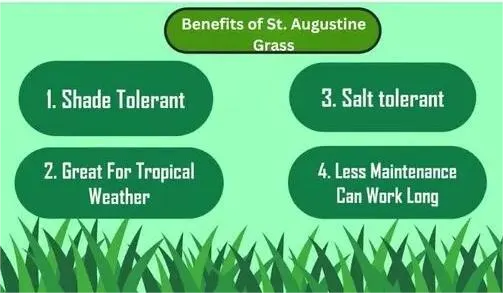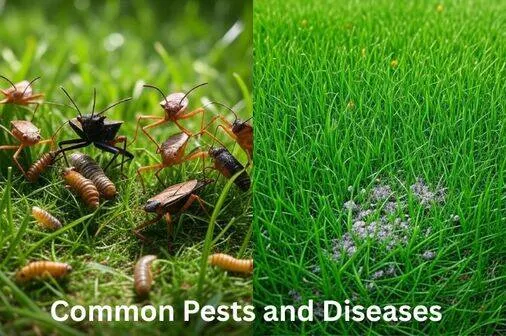The Lawn Specialists
Transform Your St. Augustine Lawn – Cape Coral
Dial (239) 475-0090
The Ultimate Guide to St. Augustine Grass
If you are looking for professional lawn care in Cape Coral, maintaining a healthy St. Augustine lawn is essential. This warm season grass thrives in our subtropical climate, offering a lush, green appearance throughout the year. Proper care ensures your yard remains vibrant and resilient.
Whether you are a homeowner or a business, understanding the specific needs of St. Augustine grass can help you achieve a beautiful landscape. Explore our services for expert mowing, fertilization, and pest management to keep your lawn healthy and thriving.
What is St. Augustine Grass?
St. Augustine grass (Stenotaphrum secundatum) is a warm-season, coarse-textured grass that creates a thick, lush lawn. It thrives in heat and can handle shade well, making it popular for southern yards. Less suited for heavy foot traffic, it’s ideal for low-to-moderate use landscapes.

Why St. Augustine Grass Thrives?
Cape Coral’s subtropical climate, with average temperatures of 45°F to 95°F and annual rainfall of about 53 inches, creates perfect conditions . Its tolerance for humidity, salt, and partial shade makes it a favorite for local yards. Popular varieties like Floratam and Palmetto resist common pests like chinch bugs and handle the area’s sandy, nutrient-poor soils well.
Benefits

Planting St. Augustine Grass
Optimal Planting Time
In spring (April-May) when temperatures consistently exceed 80°F. This timing allows strong root development before rainy season (June-September).
Planting Methods
This is typically installed as sod or plugs due to limited seed availability:
Soil Preparation
Test soil pH (ideal: 6.0-7.5) using a kit, and add compost to sandy soils to boost nutrient retention. Ensure good drainage.
Watering Guidelines
Heavy rainfall often meets St. Augustine’s needs during the wet season, but strategic watering is key:
Overwatering can cause fungal issues, so monitor soil moisture closely.
Mowing and Maintenance Tips
Mowing Height
Keep it at 2.5-4 inches, with Floratam favoring the higher end. Mow every 5-7 days in summer and less frequently in winter. Never cut more than one-third of the blade length to avoid stress.
Mowing Best Practices
Use sharp blades to prevent tearing, which invites pests. Avoid scalping to protect stolons (runners). Clean equipment to prevent disease spread.
Dethatching and Aeration
Remove thatch (dead organic matter) exceeding 1 inch in spring using a rake or dethatcher. Aerate annually to relieve soil compaction, especially in high-traffic areas, to improve water and nutrient uptake.

Fertilizing for a Healthy Lawn
Sandy soils require regular fertilization to maintain:
Soil tests, available through UF/IFAS, ensure balanced nutrient application.

Managing Pests and Diseases
Common Pests
Common Diseases
Consult our experts for precise treatments.

Weed Control
Seasonal Care Schedule
Pros and Cons
Pros and Cons
Characteristics
Choosing the Right Variety
Extra Tips for Success
Five Reasons to Love St. Augustine Grass
How to Plant and Grow
Growing it can be tricky since establishing a yard from seed is challenging, and seeds are hard to find. Experts typically recommend using sod or plugs instead. For the best results, source sod from a turf farm or collaborate with a landscaping professional. The upside is that St. Augustine sod establishes effectively once laid. You can start your lawn anytime during the growing season, just ensure consistent watering after installation to encourage root growth.
When and How to Fertilize
To maintain a vibrant yard, timing your fertilization is key. Start in early spring as the greenery begins to green up, then fertilize every six to eight weeks during the growing season. Finish with a final application in early fall, at least six weeks before the first frost. What’s the best fertilizer? Opt for one with an NPK (nitrogen-phosphorus-potassium) ratio of 4-1-2, 3-1-2, or 3-0-0. Apply 0.5 to 1 pound of nitrogen per 1,000 square feet, or 1.5 pounds of slow-release nitrogen per 1,000 square feet.
How to Get St. Augustine Grass to Spread
It spreads naturally via stolons, above-ground runners that form nodes, sprouting roots and new blades for a dense lawn. During peak season, stolons grow several inches weekly. To encourage spreading, maintain proper watering (¾-1 inch weekly), fertilize with high-nitrogen fertilizer (2-4 pounds per 1,000 sq ft annually), and mow at 2.5-4 inches, cutting no more than one-third of the blade.
Keep Your Lawn Lush with St. Augustine Grass
It is ideal for southern regions, delivering a lush lawn with proper care. For low-maintenance upkeep, hire Our professionals for sod installation and ongoing yard care to maintain a vibrant yard.
Ideal Growing Conditions
It, including its Palmetto and Raleigh varieties, is valued for its versatility across various landscaping settings, thriving under specific conditions that support its growth and longevity.
Ideal Conditions | Specification |
Climate | Warm, with a preference for high temperatures |
Sunlight | Full sun to partial shade |
Soil Types | Sandy to clayey, requiring good drainage |
Growing Season | Late spring through summer |
Watering Needs | Consistent during the growing season, avoiding waterlogging |
Why Hire Our Expert?
Maintaining St. Augustine grass in Cape Coral’s climate demands expertise. Our professional services ensure proper pest control, fertilization, and irrigation while complying with local regulations. This saves time and enhances garden health, making your property stand out.
Conclusion
A thriving lawn boosts your property’s appeal and value. By planting correctly, watering wisely, mowing properly, fertilizing strategically, and controlling pests, you can maintain a healthy yard.
